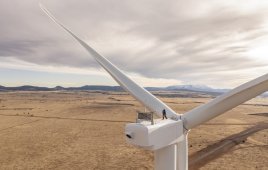A new floating platform would allow wind turbines to float offshore without water-depth restrictions. The WindFloat platform was conceived by engineering firm Marine Innovation & Technology and owned by Principle Power. The device is a floating support structure for offshore wind turbines. The structure would let turbines sit in locations with excellent wind resources that were previously off limits because water depth exceeded 50m.
The WindFloat foundation has many advantages. It’s economic because it reduces the need for offshore operations during final assembly and commissioning. Also, its static and dynamic stability offers low pitch and yaw performance, enabling use of existing commercial wind turbine technology. Its design and size allow for onshore assembly, while its shallow draft allows for depth-independent sitting and towing it to sites not visible from shore.
The design and size of the WindFloat enables overall structure assembly onshore. Horizontal water-entrapment, or heave, plates at the base of each column significantly improve the motion performance of the system, due to additional damping and entrained water effects. A closed-loop active ballast system mitigates wind-induced thrust forces, restoring the system to optimal efficiency following changes in wind velocity and direction. A catenary mooring system uses conventional components, such as chain and polyester lines to minimize the cost. Pre-laid drag-embedded anchors minimize site preparation and impact.
Marine Innovation & Technology engineers used digital prototyping to create the WindFloat. The software from Autodesk, Inc. helped design and render the device in just three weeks. Multiple project proposals are being submitted for full-scale demonstration and utility-scale developments in the UK, Europe, and U.S.
Marine Innovation & Technology www.marineitech.com
Autodesk usa.autodesk.com
Filed Under: Turbines





